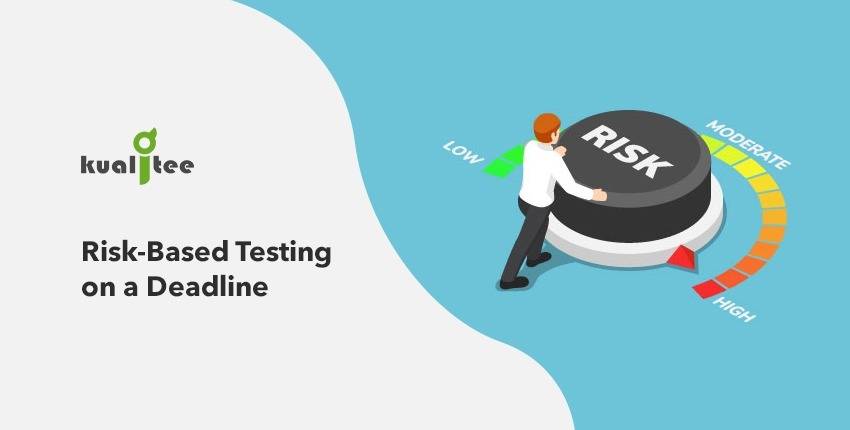Is your QA team struggling to decide where to allocate its time and efforts? A risk-based testing (RBT) strategy may be the answer to their prayers. But, how? In simple words, it’s a strategy that makes use of defined risk to test adequately for maximizing your testing goals. It follows the principles of risk management but in a testing context.
All software development projects focus on three common objectives:
- Quality
- Cost control
- Time-to-market
These objectives can be affected by both internal and external risks due to various reasons. In case of negative risks, the risk level is dependent on the factors such as the likelihood of failure, frequency of usage, number of impacted users, the complexity of change, etc.
Quality is another aspect in the equation. Risks can also hurt the quality of a product and its purpose of ensuring that a product has as few bugs as possible or at least a reduced probability of bugs in risky/important areas.
If, while using software testing tools, testing is performed with the purpose of avoiding/finding bugs, then RBT can be used to serve the purpose of mitigation or even as an avoidance strategy. With RBT, you testing related decisions can be made based on the assessment of risks.
The Purpose of RBT
Main purpose: Using risk management principles for adequate testing.
First and foremost, RBT ensures clear communication about risks between stakeholders, clients, developers, and testers by providing a sufficient framework. RBT helps in defining terms and agreeing on a common language to make risks visible and actionable.
RBT takes the big picture into account as it covers the needs of both the customers and the developers. It uses risks, specifically, as the input to support the activities of testing.
Customers are typically more concerned about costs, visible quality, timing, and business features. Whereas, the concerns of the development team are much similar to these except that it perceives quality in a broader scope as it has to maintain and evolve with the product being developed.
Factors such as costs and time need effective management to avoid delays and be on a budget; however, quality must not be compromised and to meet cost/timing criteria, leverage RBT to ensure focus on issues/features that customers are most concerned about.
5 Major Benefits
- More focus on the customer
- Enables thorough testing of most concerned areas
- Deliver what’s most important
- Minimized impact and probability of negative risks
- Focusses testing on higher, negative risks
- Lowers the probability of missing important defects
- Reduces the impact of the risks
- Increased confidence
- Helps find more important risks first by focusing on higher risks
- Ensures exhaustive testing of important items
- Helps release products with a higher level of confidence
- Optimized costs and QA efforts
- Provides certainty regarding what to test, where to start, when to stop, etc.
- Provides the means to define the testing scope
- Identifies what tests to execute and when
- Provides a way to choose tests for regression testing
- Provides some clues for selecting candidates for automation
- Better risk-based decisions
- Gives visibility of risks to make a “go/no go” decision
- Helps overcome risks that block acceptance
- Implicitly explains why certain tests were executed over the other ones
- Eases communication with other stakeholders regarding decisions
The Overall RBT Process
- Risk Identification
The first step is to determine what and how things can affect our project. First of all, the risks are identified using relevant software testing tools and discussed by the team. This is done before implementation starts and throughout the SDLC, the identified risks are reviewed since new risks can be identified during the process.
- Risk Analysis
In this stage, the risks and their probabilities and impacts are discussed and calculated to determine how they can be handled in the most effective way.
- Risk Evaluation and Treatment
This step starts with the question with which we ended the last step, “How will we handle it in the most effective way?” There are certain aspects that need to be attended to get the answer.
- Test Planning
By using the input from risk analysis, test managers can define test strategy, estimate, testing efforts and estimate/define the schedule.
- Test Design
Tests are designed to mitigate the risk and make use of more extensive data with data-driven testing and automated testing/checking using software testing tools if needed.
- Test Execution
Tests are performed in the descending order of the risk level. Risky items are thoroughly tested using exploratory and scripted approaches.
Risk Monitoring and Reviewing
At this stage, you look at items where the risk was assessed and evaluate whether additional treatments/measures need to be taken or not.
Conclusion
The definition of risk-based testing is entirely up to you.
It can be as simple or complicated as you want it to be. It’s adaptable to different scenarios and workflows including Hybrid, Agile or Waterfall. Whichever route you decide to take, RBT will give you the indicators, common language, and framework to optimize your costs and efforts and make wise testing decisions.


























